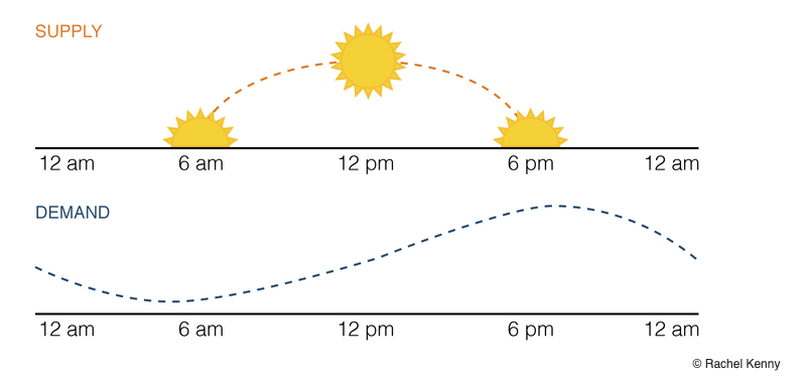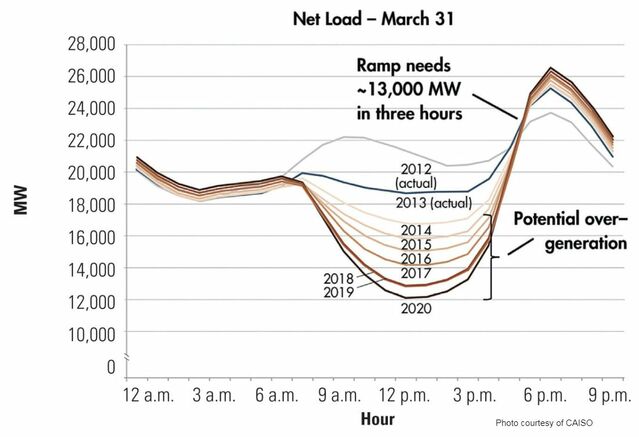BACKGROUND
Electric Vehicles & the Grid
Transportation accounts for 40% of California’s greenhouse gas emissions (GHGs). To reduce these emissions, the state is incentivizing electrification of the transportation sector. Current state targets aim to increase the number of zero emission vehicles on the road from 570,000 to 5 million by 2030.
The integration of electric vehicle (EV) charging onto the electrical grid, if left unmanaged, could create an increase in evening peak electricity demand that has to be met by carbon-intensive fossil fuel resources, such as natural gas. The potential increase in peak demand may stress electrical grid infrastructure and limit the greenhouse gas (GHG) and air pollution benefits of EVs. The climate benefits of EVs, however, are partly tied to when they charge. If managed effectively, EV charging could be shifted to the middle of the day, when California has an excess of solar energy.
Currently, midday charging demand is lower than supply. When that excess solar energy supply isn't used up by demand, it's often shut down or sold for a loss in process known as "grid curtailment." The continued growth of solar energy without any change in demand has led to what’s known as “The Duck Curve,” where the net load and overgeneration of solar energy can lead to a steep ramping up of electricity demand in a short time period to meet the evening demand peak.
Why is this important?
That steep ramp is forming when variable generation such as solar is tapering in the late afternoon and evening, the same time demand becomes the highest. This demand has to be met with fossil-fuel based power plants that can be dispatched quickly. This could lead to more GHG emissions, countering California’s goal to reduce GHG emissions.
Charging in the middle of the day would allow EVs to take advantage of California’s surplus solar energy to maximize their potential to reduce greenhouse gas and air pollution emissions and help balance supply and demand on the electrical grid.
That steep ramp is forming when variable generation such as solar is tapering in the late afternoon and evening, the same time demand becomes the highest. This demand has to be met with fossil-fuel based power plants that can be dispatched quickly. This could lead to more GHG emissions, countering California’s goal to reduce GHG emissions.
Charging in the middle of the day would allow EVs to take advantage of California’s surplus solar energy to maximize their potential to reduce greenhouse gas and air pollution emissions and help balance supply and demand on the electrical grid.
Utility Interest
Southern California Edison (SCE), the largest electric utility in Southern California, is investigating ways to incentivize EV drivers to shift their charging to the middle of the day through their Charge Ready Pilot. To complement this work, our team developed models estimating how price and non-price interventions encourage drivers to shift to charging midday in four longdwell locations:
|
WORKPLACES
|
DESTINATION CENTERS
|
FLEETS
|
MULTI-UNIT DWELLINGS
|
PROJECT OBJECTIVES & RESEARCH QUESTIONS
Objectives
|
EVALUATE
|
BUILD
|
COMPARE
|
CREATE
|
Our first objective is to EVALUATE what makes EV drivers change their charging behavior and shift their charging to midday. By conducting a literature review, we were able to determine the inputs that would be put into our model.
Once we knew our inputs, we were able to BUILD a model that would simulate EV charging demand. This new charging profile and the associated greenhouse gas emission and pollution impacts would become our outputs. We could then COMPARE these model outputs to the demand response events that SCE have run in their Charge Ready pilot. By analyzing the data from these events, we could see how accurate our model was.
Our final objective was to CREATE a web-based application that allows a user to access our model, choosing a variety of different inputs to see how charging demand might change and what impact that would have.
Once we knew our inputs, we were able to BUILD a model that would simulate EV charging demand. This new charging profile and the associated greenhouse gas emission and pollution impacts would become our outputs. We could then COMPARE these model outputs to the demand response events that SCE have run in their Charge Ready pilot. By analyzing the data from these events, we could see how accurate our model was.
Our final objective was to CREATE a web-based application that allows a user to access our model, choosing a variety of different inputs to see how charging demand might change and what impact that would have.
Research Questions
In order to evaluate how EV charging could benefit the electrical grid and support climate and air pollution goals by using the excess supply of midday solar energy, we examine 3 research questions:
















